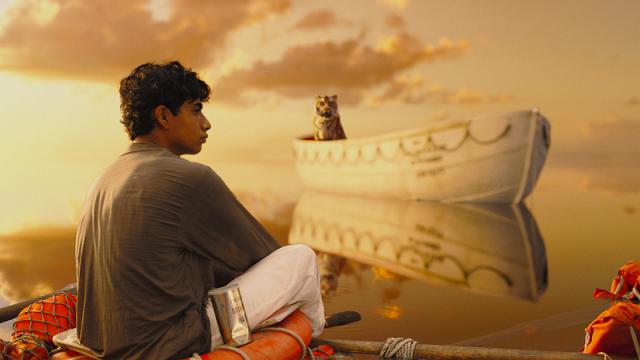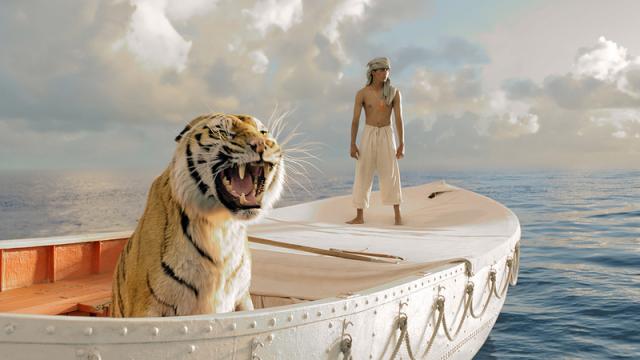
It’s a filmmaker’s nightmare. With its Indian zoo scenes, tiger antagonist, and Pacific Ocean vistas, Life of Pi requires a big special effects budget. But the adrenaline-fuelled climax (a shipwreck) is an early scene, and the majority of the story then unfolds as a series of personal revelations at sea, with little dialogue. Oh, and the actor that carries these slower scenes is a teenager.
Before Ang Lee took the director’s chair, many others had signed on to the challenge before stepping down, including M. Night Shyamalan, Alfonso Cuarón, and Jean-Pierre Jeunet.
Lee’s 3D film adaptation of the 2001 novel by Canadian writer Yann Martel finished shooting in Montreal. The movie has added a framing structure not found in the book. Searching for story material, a writer (Rafe Spall) visits Pi Patel (Irrfan Khan) in Montreal to learn about his amazing past. When he was sixteen (Suraj Sharma), Pi survived a shipwreck along with a zebra, orangutan, hyena, and Bengal tiger (named Richard Parker), crossing the Pacific Ocean on a lifeboat.
The film’s visuals are stunning, including the creation of Parker by combining footage of four real tigers and CGI. The blend is seamless, and an interesting parallel to the mix of reality and mirage described in the storyline. Sharma, a first-time actor, is impressive. It’s not easy to act with so much green screen.


The Art of Adaptation
The film’s Montreal premiere took place at the Festival du nouveau cinéma last month. Martel, accompanied by family members to the screening, chatted with journalists about the adaptation. Calling the movie “a very powerful experience,” he says the screenplay by David Magee is “very faithful.” If he had written it, however, he might have done things differently. “A novel of 330 pages contains many movies,” he says. “But I’m a writer. I’m not a screenwriter. And there’s something in screenplays that works that a literary writer doesn’t necessarily know. So I might have done things differently. But does that mean they would have been better? I’m not sure.”
“A movie is necessarily a selection of something in a book that tries to convey the same message,” Martel continues. He points to one episode in the novel, a clash between three wise men representative of Hinduism, Christianity, and Islam. It has been cut from the film, as has most of Life of Pi’s religious philosophy. Viewers who have not read the book might find a storyline at the start of the film following Pi’s conversions to the three religions as out of place, with no clear follow-up during the rest of the film. “I trusted Ang Lee,” says Martel, however. “He’s a great film director. I was so happy when he was the one who was going to do it. So I let go.”
According to the writer, setting Life of Pi into stone onscreen can even be positive. “It captures immediately what you’re trying to describe,” he explains. “It was very hard to try to describe a physical object that people are not familiar with. For example, solar stills, with which you get fresh water… Well, the movie can accomplish that in a second. The movie will bring a certain visual clarity.”
Lee’s film also captures Pi’s homeland more vividly. “The novel starts in India, of course, but when you read it, unless you’re a ventriloquist and you read it with Indian accents, you forget that. You filter that out. The movie, you will see, is very Indian. I suspect people will miss some of the dialogue because it’s too Indian! The Indian accent, the Indian locale, really come through,” said Martel.
Life of Pi
In theatres November 21











